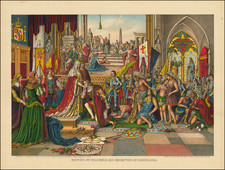An Excellent and Enigmatic Revolutionary War Era Portrait of George Washington.
The 1779 portrait, George Washington, Commandant en Chef des Armees Americaines, Né en Virginie en 1733, engraved by Augustin St. Aubin after an original painting by Charles Willson Peale, stands as a poignant portrait of the American Revolutionary War leader. Executed in Paris in 1779, this engraving holds historical significance beyond its artistic merit. It carries an intricate connection to the era's geopolitical currents, further illuminated by contemporaneous French periodical descriptions.
Two detailed descriptions of the engraving, found in the French periodicals Catalogue hebdomadaire and Mercure de France from late 1779, provide valuable context and temporal markers. Notably, they both highlight that the engraving was made under the watchful eye of Benjamin Franklin and was verified against a portrait brought to France by Marquis de Lafayette. This information offers compelling evidence for the creation of the engraving in 1779.
Lafayette, a key figure in the American Revolution, had left America in January 1779 and returned to France in February the same year. This period aligns with Charles Willson Peale's expedition to create his famed "Washington at Princeton" portrait. Consequently, it seems plausible that Lafayette would have carried another portrait of Washington, against which St. Aubin's engraving was compared and verified.
Further, the periodicals’ dates provide additional support for the engraving's creation in early fall of 1779. The Catalogue hebdomadaire notes the engraving in its October issue, while the Mercure de France mentions it in November. As such, these contemporary sources corroborate that the engraving was indeed made in 1779, likely in the early fall.
Thus, St. Aubin's engraving emerges as more than a striking representation of George Washington in military dress, nested within an oval medallion set in a rectangular frame. It becomes an artifact intricately woven into the historical tapestry of the American Revolutionary War, its creation bearing the imprint of significant figures and events of the era. The engraving, by virtue of its creation, offers a window into the international dimensions of the American Revolution, underlining the war's reverberations across the Atlantic.
Periodical Descriptions
The following advertisements are quoted in Bocher's catalogue raisonné of the engravings of Augustin de St. Aubin. Curiously, despite his own evidence, Bocher says that the engraving was made in 1776, which is not possible.
Catalogue hebdomadaire, 30 8bre 1779, n°4, art. 14. -- Portrait de Georges Washington, commandant en chef des armées américaines, pour servir de pendant à celui de Benjamin Franklin, dessiné par M. Cochin et gravé par M. de St-Aubin. 2 liv. 8 sols. A Paris, chez Cochin, aux galeries du Louvre,
N. B. Cette gravure a été faite sous les yeux de M. Franklin, d'après un portrait fait d'après nature, et vérifié sur celui que M. de La Fayette a apporté en France.
Mercure de France, 9bre 1779.- Portrait de G. Washington, commandant en chef des armées américaines, format grand in-4°, pour servir de pendant à celui de Benjamin Franklin, dessiné par M. Cochin et gravé par Aug, de St-Aubin. Se trouve à Paris, chez M. Cochin, aux galeries du Louvre, et chez Aug. de St-Aubin, graveur du Roi et de sa Bibliothèque, demeurant actuellement rue Thérèse, butte Saint-Roch, et à la Bibliothèque du Roi.
Cette gravure a été faite sous les yeux de M. Franklin, d'après un portrait fait d'après nature, et vérifié sur celui que M. de La Fayette a apporté en France.









![(Early Computer Imaging) [A La Mémoire de J.M. Jacquard.]](https://storage.googleapis.com/raremaps/img/small/79513.jpg)

![[Illustration of Foreign Attendants] [lkoku-jin zuishin no zu]](https://storage.googleapis.com/raremaps/img/small/55556.jpg)
![(California Photographs) [Group of 4 photographs of John H. Boden of Haywards, California, custom house broker in San Francisco]](https://storage.googleapis.com/raremaps/img/small/93197.jpg)
![Dacota-Krieger. Guerrier Dacota [Dakota Warrior, Wahk-Tä-Ge-Li, or Big Soldier]](https://storage.googleapis.com/raremaps/img/small/81195.jpg)
